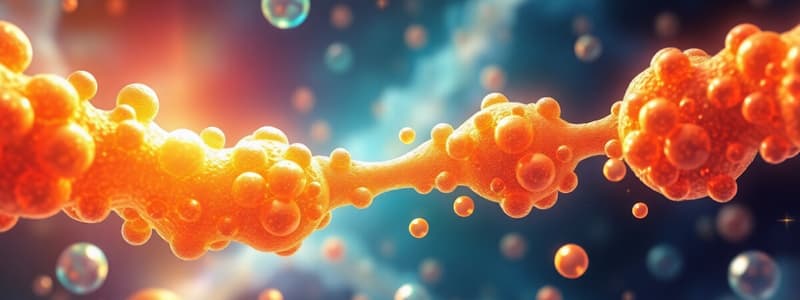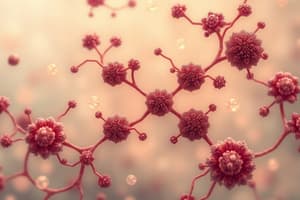Podcast
Questions and Answers
Pharmacokinetics is the study of what an administered drug does to our body.
Pharmacokinetics is the study of what an administered drug does to our body.
True (A)
Pharmacokinetics is the study of how the drug dose affects our response to the drug.
Pharmacokinetics is the study of how the drug dose affects our response to the drug.
False (B)
Pharmacodynamics is the study of what the body does to an administered drug.
Pharmacodynamics is the study of what the body does to an administered drug.
False (B)
Pharmacodynamics is the study of how the drug dose affects the plasma concentration of the drug.
Pharmacodynamics is the study of how the drug dose affects the plasma concentration of the drug.
Absorption always occurs before metabolism.
Absorption always occurs before metabolism.
Drug metabolism occurs only in the liver.
Drug metabolism occurs only in the liver.
Main routes of drug excretions are kidneys, biliary tract, sweat, and breast milk.
Main routes of drug excretions are kidneys, biliary tract, sweat, and breast milk.
Drug elimination can be the combined results of metabolism and excretion.
Drug elimination can be the combined results of metabolism and excretion.
Drug elimination can solely be by excretion.
Drug elimination can solely be by excretion.
Drugs reach their action site always via the systemic blood circulation.
Drugs reach their action site always via the systemic blood circulation.
A drug that always carries a positive charge (such as a quaternary (4°) ammonium compound) is readily distributed into the CNS.
A drug that always carries a positive charge (such as a quaternary (4°) ammonium compound) is readily distributed into the CNS.
A monoclonal antibody is readily filtered through the glomerular endothelium.
A monoclonal antibody is readily filtered through the glomerular endothelium.
A drug with a high plasma protein binding distributes extensively into different tissues, resulting in a large volume of distribution.
A drug with a high plasma protein binding distributes extensively into different tissues, resulting in a large volume of distribution.
A drug that is ionized extensively in the plasma is readily distributed into adipose tissues.
A drug that is ionized extensively in the plasma is readily distributed into adipose tissues.
For oral drug absorption, carrier-mediated transport and active transport are responsible for the majority of the drugs.
For oral drug absorption, carrier-mediated transport and active transport are responsible for the majority of the drugs.
Highly ionized drugs are readily absorbed orally.
Highly ionized drugs are readily absorbed orally.
The absorption rate after oral administration is expected to be faster when the administered drug is in solution than that in tablet form.
The absorption rate after oral administration is expected to be faster when the administered drug is in solution than that in tablet form.
The extent of absorption after oral administration is always expected to be higher when the administered drug is in solution than that in tablet form.
The extent of absorption after oral administration is always expected to be higher when the administered drug is in solution than that in tablet form.
First-pass hepatic metabolism refers to the metabolism by the liver after drug absorption by any route of administration.
First-pass hepatic metabolism refers to the metabolism by the liver after drug absorption by any route of administration.
When a drug has a high first-pass hepatic metabolism, the oral dose must be a lot smaller than the injection dose.
When a drug has a high first-pass hepatic metabolism, the oral dose must be a lot smaller than the injection dose.
First-pass metabolism has no bearing on oral bioavailability.
First-pass metabolism has no bearing on oral bioavailability.
Drug metabolism always inactivates drugs.
Drug metabolism always inactivates drugs.
Drug metabolism may activate a drug.
Drug metabolism may activate a drug.
Drug metabolism always forms a toxic metabolite during phase 1 reactions that follows by a detoxification with phase 2 conjugation.
Drug metabolism always forms a toxic metabolite during phase 1 reactions that follows by a detoxification with phase 2 conjugation.
Prodrugs are designed to be activated after metabolism.
Prodrugs are designed to be activated after metabolism.
Phase II reactions are catalyzed by the cytochrome P450 enzyme system.
Phase II reactions are catalyzed by the cytochrome P450 enzyme system.
Endogenous substrates such as glucuronic acid and glutathione are conjugated to parent drugs or drug metabolites during phase I metabolism.
Endogenous substrates such as glucuronic acid and glutathione are conjugated to parent drugs or drug metabolites during phase I metabolism.
Drugs conjugated with glucuronic acid are more readily excreted by the kidneys, not by the biliary route.
Drugs conjugated with glucuronic acid are more readily excreted by the kidneys, not by the biliary route.
Conjugation in phase II metabolism can turn a lipophilic drug into a hydrophilic metabolite.
Conjugation in phase II metabolism can turn a lipophilic drug into a hydrophilic metabolite.
Sulfation is a phase I reaction that turns a more hydrophilic drug into a more lipophilic metabolite.
Sulfation is a phase I reaction that turns a more hydrophilic drug into a more lipophilic metabolite.
CYP stands for cytochrome P450 enzyme system.
CYP stands for cytochrome P450 enzyme system.
Significant drug interactions can be mediated by induction, but not inhibition of CYP enzyme system.
Significant drug interactions can be mediated by induction, but not inhibition of CYP enzyme system.
CYP1A4 is the most significant isoform responsible for drug metabolism.
CYP1A4 is the most significant isoform responsible for drug metabolism.
CYP enzyme system is found in the intestine and the liver.
CYP enzyme system is found in the intestine and the liver.
Ritonavir is a drug that has inhibitory effects on a number of CYP isoforms.
Ritonavir is a drug that has inhibitory effects on a number of CYP isoforms.
Renal drug excretion is not affected by the degree of ionization of the drug in the glomerular filtrate.
Renal drug excretion is not affected by the degree of ionization of the drug in the glomerular filtrate.
PH of the urine does not affect renal drug excretion.
PH of the urine does not affect renal drug excretion.
A highly plasma protein-bound drug is readily excreted by the kidneys.
A highly plasma protein-bound drug is readily excreted by the kidneys.
Area under the plasma drug concentration-time curve (AUC in short) is a measure of drug dose for administration.
Area under the plasma drug concentration-time curve (AUC in short) is a measure of drug dose for administration.
AUC of a drug can be highly dependent on absorption and metabolism.
AUC of a drug can be highly dependent on absorption and metabolism.
Assuming first-order kinetics, elimination half-life (T1/2) of Drug B is 60 hours. The time to steady state is approximately 180 hours.
Assuming first-order kinetics, elimination half-life (T1/2) of Drug B is 60 hours. The time to steady state is approximately 180 hours.
For a drug with a long half-life (T1/2), it can be administered at long dosing intervals.
For a drug with a long half-life (T1/2), it can be administered at long dosing intervals.
For a drug with a short T1/2, a loading dose is often required when a fast onset of drug action is desirable.
For a drug with a short T1/2, a loading dose is often required when a fast onset of drug action is desirable.
Flashcards are hidden until you start studying
Study Notes
Pharmacokinetics
- Pharmacokinetics studies how the body affects a drug.
- Pharmacodynamics studies how a drug affects the body.
- Absorption: Happens before metabolism, but not always.
- Drug metabolism: Can occur in organs other than liver.
- Excretion: Main routes include kidneys, biliary tract, sweat, and breast milk.
- Elimination: Can involve a combination of metabolism and excretion.
- Elimination: Can occur solely through excretion.
- Distribution: Drugs reach their action site via systemic blood circulation.
- Distribution: Positively charged drugs, like quaternary ammonium compounds, do not readily enter the CNS.
- Distribution: Monoclonal antibodies do not easily pass through the glomerular endothelium.
- Distribution: Drugs with high plasma protein binding have lower tissue distribution, resulting in smaller volumes of distribution.
- Distribution: Highly ionized drugs are not easily distributed into adipose tissue.
- Absorption: Carrier-mediated transport and active transport play significant roles for orally administered drugs.
- Absorption: Highly ionized drugs are poorly absorbed orally.
- Absorption: Drugs in solution are absorbed faster than tablet forms.
- Absorption: Drug absorption extent might be higher in solutions compared to tablets, but it's not always guaranteed.
- First-pass hepatic metabolism: This occurs after drug absorption from any route, not just oral administration.
- First-pass hepatic metabolism: Drugs with high first-pass effect require higher oral doses than injection doses.
- First-pass hepatic metabolism: It significantly impacts a drug's oral bioavailability.
- Metabolism: Can either inactivate or activate drugs.
- Metabolism: Phase 1 reactions can result in toxic metabolites, but they are usually detoxified during Phase II conjugation.
- Prodrugs: Designed for activation after metabolism.
- Phase II reactions: Catalyzed by enzymes other than cytochrome P450.
- Phase II reactions: Endogenous substrates like glucuronic acid and glutathione get conjugated during Phase I, not Phase II.
- Conjugation: Drugs conjugated with glucuronic acid are more easily excreted by the kidneys, not necessarily the biliary route.
- Conjugation: Turns lipophilic drugs into hydrophilic metabolites.
- Sulfation: A Phase II reaction that turns hydrophilic drugs more lipophilic.
- CYP: Abbreviation for cytochrome P450 enzyme system.
- CYP system: Drug interactions can occur through both induction and inhibition of the system.
- CYP system: CYP1A4 is not the most significant isoform for drug metabolism.
- CYP system: Found in the intestine and liver.
- CYP system: Ritonavir inhibits multiple CYP isoforms.
- Renal excretion: Affected by the degree of ionization of the drug in the glomerular filtrate.
- Renal excretion: pH of urine influences renal excretion.
- Renal excretion: Highly plasma protein-bound drugs are poorly excreted by kidneys.
- AUC: Area under the plasma drug concentration-time curve is a measure of drug exposure in the body, not the dose administered.
- AUC: Highly dependent on drug absorption and metabolism rates.
- Half-life: Time to steady state is approximately 4-5 times the half-life.
- Half-life: Drugs with long half-lives can be dosed at longer intervals.
- Half-life: For drugs with short half-lives, a loading dose is often needed for rapid onset of action.
- Efficacy: For two drugs with the same maximum response but different EC50s, the drug with the lower EC50 has higher efficacy.
Studying That Suits You
Use AI to generate personalized quizzes and flashcards to suit your learning preferences.




